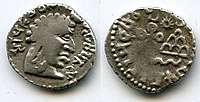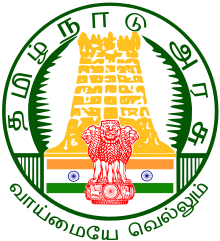Tamil language
Tamil (/ˈtæmɪl/; தமிழ் Tamiḻ [tamiɻ], ![]()
| Tamil | |
|---|---|
| தமிழ் Tamiḻ | |
 | |
| Pronunciation | [tamiɻ]; |
| Native to | India Sri Lanka |
| Ethnicity | Tamil people |
Native speakers | 75 million (2011–2015)[1][2] L2 speakers: 6 million[1] |
Dravidian
| |
Early forms | Old Tamil
|
| Tamil (Brahmic) Tamil-Brahmi (historical) Grantha (historical) Vatteluttu (historical) Pallava (historical) Kolezhuthu (historical) Arwi (Abjad) Tamil Braille (Bharati) Latin script (informal) | |
| Signed Tamil | |
| Official status | |
Official language in | Organizations |
Recognised minority language in | |
| Language codes | |
| ISO 639-1 | ta |
| ISO 639-2 | tam |
| ISO 639-3 | Either:tam – Modern Tamiloty – Old Tamil |
oty Old Tamil | |
| Glottolog | tami1289 Modern Tamil[9]oldt1248 Old Tamil[10] |
| Linguasphere | 49-EBE-a |
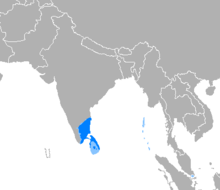 | |
Tamil is one of the longest-surviving classical languages in the world.[15][16] A. K. Ramanujan described it as "the only language of contemporary India which is recognizably continuous with a classical past."[17] The variety and quality of classical Tamil literature has led to it being described as "one of the great classical traditions and literatures of the world".[18]
A recorded Tamil literature has been documented for over 2000 years.[19] The earliest period of Tamil literature, Sangam literature, is dated from ca. 300 BC – AD 300.[20][21] It has the oldest extant literature among Dravidian languages.[15] The earliest epigraphic records found on rock edicts and 'hero stones' date from around the 3rd century BC.[22][23] More than 55% of the epigraphical inscriptions (about 55,000) found by the Archaeological Survey of India are in the Tamil language.[24] Tamil language inscriptions written in Brahmi script have been discovered in Sri Lanka and on trade goods in Thailand and Egypt.[25][26] The two earliest manuscripts from India,[27][28] acknowledged and registered by the UNESCO Memory of the World register in 1997 and 2005, were written in Tamil.[29]
In 1578, Portuguese Christian missionaries published a Tamil prayer book in old Tamil script named Thambiran Vanakkam, thus making Tamil the first Indian language to be printed and published.[30] The Tamil Lexicon, published by the University of Madras, was one of the earliest dictionaries published in the Indian languages.[31] According to a 2001 survey, there were 1,863 newspapers published in Tamil, of which 353 were dailies.[32]
Classification
Tamil belongs to the southern branch of the Dravidian languages, a family of around 26 languages native to the Indian subcontinent.[33] It is also classified as being part of a Tamil language family that, alongside Tamil proper, includes the languages of about 35 ethno-linguistic groups[34] such as the Irula and Yerukula languages (see SIL Ethnologue).
The closest major relative of Tamil is Malayalam; the two began diverging around the 9th century AD.[35] Although many of the differences between Tamil and Malayalam demonstrate a pre-historic split of the western dialect,[36] the process of separation into a distinct language, Malayalam, was not completed until sometime in the 13th or 14th century.[37]
History
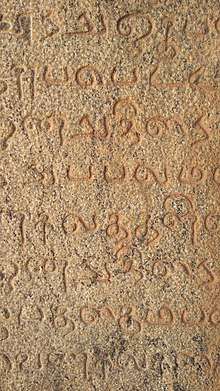
According to linguists like Bhadriraju Krishnamurti, Tamil, as a Dravidian language, descends from Proto-Dravidian, a proto-language. Linguistic reconstruction suggests that Proto-Dravidian was spoken around the third millennium BC, possibly in the region around the lower Godavari river basin in peninsular India. The material evidence suggests that the speakers of Proto-Dravidian were of the culture associated with the Neolithic complexes of South India.[38] The earliest epigraphic attestations of Tamil are generally taken to have been written from the 2nd century BC.[39]
Among Indian languages, Tamil has the most ancient non-Sanskritic Indian literature.[40] Scholars categorise the attested history of the language into three periods: Old Tamil (300 BC–AD 700), Middle Tamil (700–1600) and Modern Tamil (1600–present).[41] In November 2007, an excavation at Quseir-al-Qadim revealed Egyptian pottery dating back to first century BC with ancient Tamil Brahmi inscriptions.[25] John Guy states that Tamil was the lingua franca for early maritime traders from India.[42]
Legend

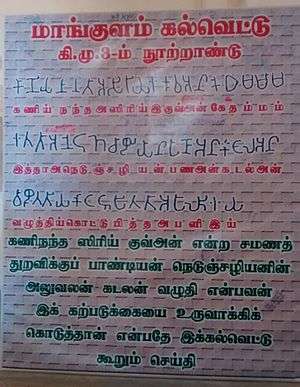
According to Hindu legend, Tamil or in personification form Tamil Thāi (Mother Tamil) was created by Lord Shiva. Murugan, revered as the Tamil God, along with sage Agastya, brought it to the people.[47]
Etymology
The earliest extant Tamil literary works and their commentaries celebrate the Pandiyan Kings for the organization of long-termed Tamil Sangams, which researched, developed and made amendments in Tamil language. Even though the name of the language which was developed by these Tamil Sangams is mentioned as Tamil, the period when the name "Tamil" came to be applied to the language is unclear, as is the precise etymology of the name. The earliest attested use of the name is found in Tholkappiyam, which is dated as early as late 2nd century BC.[48][49]Southworth suggests that the name comes from tam-miḻ > tam-iḻ "self-speak", or "one's own speech".[50] Kamil Zvelebil suggests an etymology of tam-iḻ, with tam meaning "self" or "one's self", and "-iḻ" having the connotation of "unfolding sound". Alternatively, he suggests a derivation of tamiḻ < tam-iḻ < *tav-iḻ < *tak-iḻ, meaning in origin "the proper process (of speaking)".[51]
The Tamil Lexicon of University of Madras defines the word "Tamil" as "sweetness".[52] S. V. Subramanian suggests the meaning "sweet sound", from tam — "sweet" and il — "sound".[53]
Old Tamil
Old Tamil is the period of the Tamil language spanning the 3rd century BC to the 8th century AD. The earliest records in Old Tamil are short inscriptions from between the 3rd and 2nd century BC in caves and on pottery. These inscriptions are written in a variant of the Brahmi script called Tamil-Brahmi.[54] The earliest long text in Old Tamil is the Tolkāppiyam, an early work on Tamil grammar and poetics, whose oldest layers could be as old as the late 2nd century BC.[41][55] Many literary works in Old Tamil have also survived. These include a corpus of 2,381 poems collectively known as Sangam literature. These poems are usually dated to between the 1st century BC and 5th century AD.[41][56]
Middle Tamil
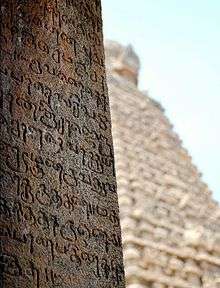
The evolution of Old Tamil into Middle Tamil, which is generally taken to have been completed by the 8th century,[41] was characterised by a number of phonological and grammatical changes. In phonological terms, the most important shifts were the virtual disappearance of the aytam (ஃ), an old phoneme,[57] the coalescence of the alveolar and dental nasals,[58] and the transformation of the alveolar plosive into a rhotic.[59] In grammar, the most important change was the emergence of the present tense. The present tense evolved out of the verb kil (கில்), meaning "to be possible" or "to befall". In Old Tamil, this verb was used as an aspect marker to indicate that an action was micro-durative, non-sustained or non-lasting, usually in combination with a time marker such as ṉ (ன்). In Middle Tamil, this usage evolved into a present tense marker – kiṉṟa (கின்ற) – which combined the old aspect and time markers.[60]
Modern Tamil
The Nannul remains the standard normative grammar for modern literary Tamil, which therefore continues to be based on Middle Tamil of the 13th century rather than on Modern Tamil.[61] Colloquial spoken Tamil, in contrast, shows a number of changes. The negative conjugation of verbs, for example, has fallen out of use in Modern Tamil[62] – instead, negation is expressed either morphologically or syntactically.[63] Modern spoken Tamil also shows a number of sound changes, in particular, a tendency to lower high vowels in initial and medial positions,[64] and the disappearance of vowels between plosives and between a plosive and rhotic.[65]
Contact with European languages affected written and spoken Tamil. Changes in written Tamil include the use of European-style punctuation and the use of consonant clusters that were not permitted in Middle Tamil. The syntax of written Tamil has also changed, with the introduction of new aspectual auxiliaries and more complex sentence structures, and with the emergence of a more rigid word order that resembles the syntactic argument structure of English.[66] Simultaneously, a strong strain of linguistic purism emerged in the early 20th century, culminating in the Pure Tamil Movement which called for removal of all Sanskritic elements from Tamil.[67] It received some support from Dravidian parties.[68] This led to the replacement of a significant number of Sanskrit loanwords by Tamil equivalents, though many others remain.[69]
Geographic distribution
Tamil is the primary language of the majority of the people residing in Tamil Nadu, Puducherry, (in India) and in Northern Province, Eastern Province (Sri Lanka). The language is spoken among small minority groups in other states of India which include Karnataka, Andhra Pradesh, Kerala, Maharashtra and in certain regions of Sri Lanka such as Colombo and the hill country. Tamil or dialects of it were used widely in the state of Kerala as the major language of administration, literature and common usage until the 12th century AD. Tamil was also used widely in inscriptions found in southern Andhra Pradesh districts of Chittoor and Nellore until the 12th century AD.[70] Tamil was used for inscriptions from the 10th through 14th centuries in southern Karnataka districts such as Kolar, Mysore, Mandya and Bangalore.[71]
There are currently sizeable Tamil-speaking populations descended from colonial-era migrants in Malaysia, Singapore, Philippines, Mauritius, South Africa, Indonesia,[72] Thailand,[73] Burma, and Vietnam. A large community of Pakistani Tamils speakers exists in Karachi, Pakistan, which includes Tamil-speaking Hindus[74][75] as well as Christians and Muslims – including some Tamil-speaking Muslim refugees from Sri Lanka.[76] There are about 100 Tamil Hindu families in Madrasi Para colony in Karachi .They speak impeccable Tamil along with Urdu, Punjabi and Sindhi.[77] Many in Réunion, Guyana, Fiji, Suriname, and Trinidad and Tobago have Tamil origins,[78] but only a small number speak the language. In Reunion where the Tamil language was forbidden to be learnt and used in public space by France it is now being relearnt by students and adults.[79] Tamil is also spoken by migrants from Sri Lanka and India in Canada, the United States (especially New Jersey and New York City), Australia, the United Kingdom, South Africa, and many other European and Middle Eastern countries.
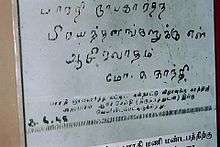 Mahatma Gandhi's written wishes in Tamil for Subramanya Bharathy
Mahatma Gandhi's written wishes in Tamil for Subramanya Bharathy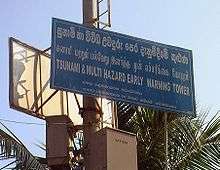
 Nameboard with Tamil at Koneswaram temple at Thirukonamalai, Sri Lanka.
Nameboard with Tamil at Koneswaram temple at Thirukonamalai, Sri Lanka. A multilingual danger sign in Singapore with Tamil writing
A multilingual danger sign in Singapore with Tamil writing Mauritius currency note with Tamil 'இருநூறு ரூபாய்' (200 rupee) written in the note with the man wearing eyeglasses, written next to him.
Mauritius currency note with Tamil 'இருநூறு ரூபாய்' (200 rupee) written in the note with the man wearing eyeglasses, written next to him..jpg) A restaurant in Edison, New Jersey, near New York City, with signage in Tamil and English translation
A restaurant in Edison, New Jersey, near New York City, with signage in Tamil and English translation
Legal status
Tamil is the official language of the Indian state of Tamil Nadu and one of the 22 languages under schedule 8 of the constitution of India. It is one of the official languages of the union territories of Puducherry and the Andaman and Nicobar Islands.[80][81] Tamil is also one of the official languages of Singapore. Tamil is one of the official and national languages of Sri Lanka, along with Sinhala.[11] It was once given nominal official status in the Indian state of Haryana, purportedly as a rebuff to Punjab, though there was no attested Tamil-speaking population in the state, and was later replaced by Punjabi, in 2010.[82] In Malaysia, 543 primary education government schools are available fully in Tamil medium.[83] The establishment of Tamil medium schools has been in process in Myanmar to provide education completely in Tamil language by the Tamils who settled there 200 years ago.[84] Tamil language is available as a course in some local school boards and major universities in Canada and the month of January has been declared "Tamil Heritage Month" by the Parliament of Canada.[85][86] Tamil enjoys a special status of protection under Article 6(b), Chapter 1 of the Constitution of South Africa and is taught as a subject in schools in KwaZulu-Natal province.[87][88] Recently, it has been rolled out as a subject of study in schools in the French overseas department of Réunion.[89]
In addition, with the creation in October 2004 of a legal status for classical languages by the Government of India and following a political campaign supported by several Tamil associations,[90][91] Tamil became the first legally recognised Classical language of India. The recognition was announced by the contemporaneous President of India, Abdul Kalam, in a joint sitting of both houses of the Indian Parliament on 6 June 2004.[92][93][94]
Dialects

Region-specific variations
The socio-linguistic situation of Tamil is characterised by diglossia: there are two separate registers varying by socioeconomic status, a high register and a low one.[95][96] Tamil dialects are primarily differentiated from each other by the fact that they have undergone different phonological changes and sound shifts in evolving from Old Tamil. For example, the word for "here"—iṅku in Centamil (the classic variety)—has evolved into iṅkū in the Kongu dialect of Coimbatore, inga in the dialect of Thanjavur, and iṅkai in some dialects of Sri Lanka. Old Tamil's iṅkaṇ (where kaṇ means place) is the source of iṅkane in the dialect of Tirunelveli, Old Tamil iṅkaṭṭu is the source of iṅkuṭṭu in the dialect of Madurai, and iṅkaṭe in some northern dialects. Even now, in the Coimbatore area, it is common to hear "akkaṭṭa" meaning "that place". Although Tamil dialects do not differ significantly in their vocabulary, there are a few exceptions. The dialects spoken in Sri Lanka retain many words and grammatical forms that are not in everyday use in India,[41][97] and use many other words slightly differently.[98] Tamil dialects include Central Tamil dialect, Kongu Tamil, Madras Bashai, Madurai Tamil, Nellai Tamil, Kumari tamil in India and Batticaloa Tamil dialect, Jaffna Tamil dialect, Negombo Tamil dialect in Sri Lanka. Sankethi dialect in Karnataka has been heavily influenced by Kannada.
Loanword variations
The dialect of the district of Palakkad in Kerala has many Malayalam loanwords, has been influenced by Malayalam's syntax, and has a distinctive Malayalam accent. Similarly, Tamil spoken in Kanyakumari District has more unique words and phonetic style than Tamil spoken at other parts of Tamil Nadu. The words and phonetics are so different that a person from Kanyakumari district is easily identifiable by their spoken Tamil. Hebbar and Mandyam dialects, spoken by groups of Tamil Vaishnavites who migrated to Karnataka in the 11th century, retain many features of the Vaishnava paribasai, a special form of Tamil developed in the 9th and 10th centuries that reflect Vaishnavite religious and spiritual values.[99] Several castes have their own sociolects which most members of that caste traditionally used regardless of where they come from. It is often possible to identify a person's caste by their speech.[100] Tamil in Sri Lanka incorporates loan words from Portuguese, Dutch, and English.
Spoken and literary variants
In addition to its dialects, Tamil exhibits different forms: a classical literary style modelled on the ancient language (sankattamiḻ), a modern literary and formal style (centamiḻ), and a modern colloquial form (koṭuntamiḻ). These styles shade into each other, forming a stylistic continuum. For example, it is possible to write centamiḻ with a vocabulary drawn from caṅkattamiḻ, or to use forms associated with one of the other variants while speaking koṭuntamiḻ.[101]
In modern times, centamiḻ is generally used in formal writing and speech. For instance, it is the language of textbooks, of much of Tamil literature and of public speaking and debate. In recent times, however, koṭuntamiḻ has been making inroads into areas that have traditionally been considered the province of centamiḻ. Most contemporary cinema, theatre and popular entertainment on television and radio, for example, is in koṭuntamiḻ, and many politicians use it to bring themselves closer to their audience. The increasing use of koṭuntamiḻ in modern times has led to the emergence of unofficial ‘standard' spoken dialects. In India, the ‘standard' koṭuntamiḻ, rather than on any one dialect,[102] but has been significantly influenced by the dialects of Thanjavur and Madurai. In Sri Lanka, the standard is based on the dialect of Jaffna.
Writing system
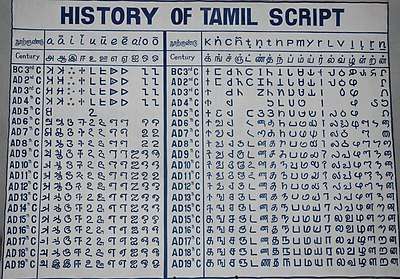

After Tamil Brahmi fell out of use, Tamil was written using a script called vaṭṭeḻuttu amongst others such as Grantha and Pallava. The current Tamil script consists of 12 vowels, 18 consonants and one special character, the āytam. The vowels and consonants combine to form 216 compound characters, giving a total of 247 characters (12 + 18 + 1 + (12 x 18)). All consonants have an inherent vowel a, as with other Indic scripts. This inherent vowel is removed by adding a tittle called a puḷḷi, to the consonantal sign. For example, ன is ṉa (with the inherent a) and ன் is ṉ (without a vowel). Many Indic scripts have a similar sign, generically called virama, but the Tamil script is somewhat different in that it nearly always uses a visible puḷḷi to indicate a 'dead consonant' (a consonant without a vowel). In other Indic scripts, it is generally preferred to use a ligature or a half form to write a syllable or a cluster containing a dead consonant, although writing it with a visible virama is also possible. The Tamil script does not differentiate voiced and unvoiced plosives. Instead, plosives are articulated with voice depending on their position in a word, in accordance with the rules of Tamil phonology.
In addition to the standard characters, six characters taken from the Grantha script, which was used in the Tamil region to write Sanskrit, are sometimes used to represent sounds not native to Tamil, that is, words adopted from Sanskrit, Prakrit and other languages. The traditional system prescribed by classical grammars for writing loan-words, which involves respelling them in accordance with Tamil phonology, remains, but is not always consistently applied.[103] ISO 15919 is an international standard for the transliteration of Tamil and other Indic scripts into Latin characters. It uses diacritics to map the much larger set of Brahmic consonants and vowels to the Latin script. Tamil can be transliterated into English by using ISO 15919, since English language uses the Latin script for writing.
Numerals and symbols
Apart from the usual numerals, Tamil has numerals for 10, 100 and 1000. Symbols for day, month, year, debit, credit, as above, rupee, and numeral are present as well. Tamil also uses several historical fractional signs.
| zero | one | two | three | four | five | six | seven | eight | nine | ten | hundred | thousand |
|---|---|---|---|---|---|---|---|---|---|---|---|---|
| ௦ | ௧ | ௨ | ௩ | ௪ | ௫ | ௬ | ௭ | ௮ | ௯ | ௰ | ௱ | ௲ |
| day | month | year | debit | credit | as above | rupee | numeral |
|---|---|---|---|---|---|---|---|
| ௳ | ௴ | ௵ | ௶ | ௷ | ௸ | ௹ | ௺ |
Phonology
| Part of a series on |
| Tamils |
|---|
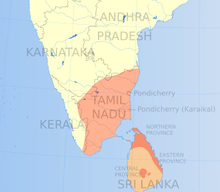 |
|
|
People
|
Tamil Australians, French Tamils, British Tamils, Tamil Italians, Tamil Indonesians, Tamil Canadians, Tamil Americans, Tamil South Africans, Myanmar Tamils, Tamil Mauritians, Tamil Germans, Tamil Pakistanis, Tamil Seychellois, Tamil New Zealanders, Swiss Tamils, Dutch Tamils |
|
Politics
|
|
|
| Part of a series on |
| Dravidian culture and history |
|---|
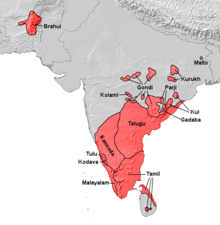 |
|
Origins Dravidian People |
|
History
|
|
Culture
|
|
Language
|
|
Regions
|
|
People
|
|
Politics |
| Portal:Dravidian civilizations |
Tamil phonology is characterised by the presence of retroflex consonants and multiple rhotics. Tamil does not distinguish phonologically between voiced and unvoiced consonants; phonetically, voice is assigned depending on a consonant's position in a word.[104] Tamil phonology permits few consonant clusters, which can never be word initial. Native grammarians classify Tamil phonemes into vowels, consonants, and a "secondary character", the āytam.
Vowels
Tamil has five vowel qualities, namely /a/, /e/, /i/, /o/ and /u/. Each may be long or short. There are two diphthongs, /aɪ/ and /aʊ/. Long vowels are about twice as long as short vowels. The diphthongs are usually pronounced about 1.5 times as long as short vowels. Most grammatical texts place them with the long vowels.
| Short | Long | |||||
|---|---|---|---|---|---|---|
| Front | Central | Back | Front | Central | Back | |
| Close | i | u | iː | uː | ||
| இ | உ | ஈ | ஊ | |||
| Mid | e | o | eː | oː | ||
| எ | ஒ | ஏ | ஓ | |||
| Open | a | (aɪ̯) | aː | (aʊ̯) | ||
| அ | ஐ | ஆ | ஒள | |||
Consonants
Tamil consonants are presented as hard, soft and medial in some grammars which roughly corresponds to plosives, nasals and approximants. Unlike most Indian languages, Tamil does not distinguish aspirated and unaspirated consonants. In addition, the voicing of plosives is governed by strict rules in centamiḻ. Plosives are unvoiced if they occur word-initially or doubled. Elsewhere they are voiced, with a few becoming fricatives intervocalically, which means that voicing is not a phonological trait for plosives. Nasals and approximants are always voiced.[105]
Tamil is characterised by its use of more than one type of coronal consonants: like many of the other languages of India, it contains a series of retroflex consonants. Notably, the Tamil retroflex series includes the retroflex approximant /ɻ/ (ழ) (example Tamil; often transcribed 'zh'), which is rare in the Indo-Aryan languages. Among the other Dravidian languages, the retroflex approximant also occurs in Malayalam (for example in 'Kozhikode'), disappeared from spoken Kannada around 1000 AD (although the character is still written, and exists in Unicode, ೞ as in ಕೊೞೆ), and was never present in Telugu. In many dialects of colloquial Tamil, this consonant is seen as disappearing and shifting to the alveolar lateral approximant /l/.[106] Dental and alveolar consonants also historically contrasted with each other, a typically Dravidian trait not found in the neighbouring Indo-Aryan languages. While this distinction can still be seen in the written language, it has been largely lost in colloquial spoken Tamil, and even in literary usage the letters ந (dental) and ன (alveolar) may be seen as allophonic.[107] Likewise, the historical alveolar stop has transformed into a trill consonant in many modern dialects.
A chart of the Tamil consonant phonemes in the International Phonetic Alphabet follows:[97]
| Labial | Dental | Alveolar | Retroflex | Palatal | Velar | |
|---|---|---|---|---|---|---|
| Plosives | p | t | ṟ | ʈ | t͡ɕ | k |
| ப | த | ற | ட | ச | க | |
| Nasals | m | n | n | ɳ | ɲ | ŋ |
| ம | ந | ன | ண | ஞ | ங | |
| Tap | ɽ | |||||
| ர | ||||||
| Central approximants | ʋ | ɻ | j | |||
| வ | ழ | ய | ||||
| Lateral approximants | l | ɭ | ||||
| ல | ள |
The plosives have voiced allophones after nasals. The sounds /f/ and /ʂ/ are peripheral to the phonology of Tamil, being found only in loanwords and frequently replaced by native sounds. There are well-defined rules for elision in Tamil categorised into classes based on the phoneme which undergoes elision.
Āytam
Classical Tamil had a phoneme called the āytam, written as ‘ஃ'. Tamil grammarians of the time classified it as a dependent phoneme (or restricted phoneme[108]) (cārpeḻuttu), but it is very rare in modern Tamil. The rules of pronunciation given in the Tolkāppiyam, a text on the grammar of Classical Tamil, suggest that the āytam could have glottalised the sounds it was combined with. It has also been suggested that the āytam was used to represent the voiced implosive (or closing part or the first half) of geminated voiced plosives inside a word.[109] The āytam, in modern Tamil, is also used to convert p to f when writing English words using the Tamil script.
Grammar
Tamil employs agglutinative grammar, where suffixes are used to mark noun class, number, and case, verb tense and other grammatical categories. Tamil's standard metalinguistic terminology and scholarly vocabulary is itself Tamil, as opposed to the Sanskrit that is standard for most Aryan languages.[110][111]
Much of Tamil grammar is extensively described in the oldest known grammar book for Tamil, the Tolkāppiyam. Modern Tamil writing is largely based on the 13th century grammar Naṉṉūl which restated and clarified the rules of the Tolkāppiyam, with some modifications. Traditional Tamil grammar consists of five parts, namely eḻuttu, sol, poruḷ, yāppu, aṇi. Of these, the last two are mostly applied in poetry.[112]
Tamil words consist of a lexical root to which one or more affixes are attached. Most Tamil affixes are suffixes. Tamil suffixes can be derivational suffixes, which either change the part of speech of the word or its meaning, or inflectional suffixes, which mark categories such as person, number, mood, tense, etc. There is no absolute limit on the length and extent of agglutination, which can lead to long words with many suffixes, which would require several words or a sentence in English. To give an example, the word pōkamuṭiyātavarkaḷukkāka (போகமுடியாதவர்களுக்காக) means "for the sake of those who cannot go" and consists of the following morphemes:
| போக | முடி | ஆத் | அ | வர் | கள் | உக்கு | ஆக |
| pōka | muṭi | āt | a | var | kaḷ | ukku | āka |
| go | accomplish | negation (impersonal) |
participle marker | nominalizer he/she who does |
plural marker | to | for |
Morphology
Tamil nouns (and pronouns) are classified into two super-classes (tiṇai)—the "rational" (uyartiṇai), and the "irrational" (akṟiṇai)—which include a total of five classes (pāl, which literally means "gender"). Humans and deities are classified as "rational", and all other nouns (animals, objects, abstract nouns) are classified as irrational. The "rational" nouns and pronouns belong to one of three classes (pāl)—masculine singular, feminine singular, and rational plural. The "irrational" nouns and pronouns belong to one of two classes: irrational singular and irrational plural. The pāl is often indicated through suffixes. The plural form for rational nouns may be used as an honorific, gender-neutral, singular form.[113]
| peyarccol (Name-words)[114] | ||||
| uyartiṇai (rational) |
aḵṟiṇai (irrational) | |||
| āṇpāl Male |
peṇpāl Female |
palarpāl Collective |
oṉṟaṉpāl One |
palaviṉpāl Many |
| Example: the Tamil words for "doer" | ||||
| ceytavaṉ He who did |
ceytavaḷ She who did |
ceytavar They who did |
ceytatu That which did |
ceytavai Those ones which did |
Suffixes are used to perform the functions of cases or postpositions. Traditional grammarians tried to group the various suffixes into eight cases corresponding to the cases used in Sanskrit. These were the nominative, accusative, dative, sociative, genitive, instrumental, locative, and ablative. Modern grammarians argue that this classification is artificial,[115] and that Tamil usage is best understood if each suffix or combination of suffixes is seen as marking a separate case.[102] Tamil nouns can take one of four prefixes: i, a, u, and e which are functionally equivalent to the demonstratives in English. For example, the word vazhi (வழி) meaning "way" can take these to produce ivvazhi (இவ்வழி) "this way", avvazhi (அவ்வழி) "that way", uvvazhi (உவ்வழி) "the medial way" and evvazhi (எவ்வழி) "which way".
Tamil verbs are also inflected through the use of suffixes. A typical Tamil verb form will have a number of suffixes, which show person, number, mood, tense, and voice.
- Person and number are indicated by suffixing the oblique case of the relevant pronoun. The suffixes to indicate tenses and voice are formed from grammatical particles, which are added to the stem.
- Tamil has two voices. The first indicates that the subject of the sentence undergoes or is the object of the action named by the verb stem, and the second indicates that the subject of the sentence directs the action referred to by the verb stem.
- Tamil has three simple tenses—past, present, and future—indicated by the suffixes, as well as a series of perfects indicated by compound suffixes. Mood is implicit in Tamil, and is normally reflected by the same morphemes which mark tense categories. Tamil verbs also mark evidentiality, through the addition of the hearsay clitic ām.[116] Verb inflection is shown below using example aḻintukkoṇṭiruntēṉ; (அழிந்துக்கொண்டிருந்தேன்); "(I) was being destroyed".
| அழி | ந்து | கொண்டு | இரு | ந்த் | ஏன் |
| aḻi | ntu | koṇṭu | iru | nt | ēn |
| root destroy |
transitivity marker intransitive |
aspect marker continuous |
aspect marker continuous |
tense marker past tense |
person marker first person, singular |
Traditional grammars of Tamil do not distinguish between adjectives and adverbs, including both of them under the category uriccol, although modern grammarians tend to distinguish between them on morphological and syntactical grounds.[117] Tamil has many ideophones that act as adverbs indicating the way the object in a given state "says" or "sounds".[118]
Tamil does not have articles. Definiteness and indefiniteness are either indicated by special grammatical devices, such as using the number "one" as an indefinite article, or by the context.[119] In the first person plural, Tamil makes a distinction between inclusive pronouns நாம் nām (we), நமது namatu (our) that include the addressee and exclusive pronouns நாங்கள் nāṅkaḷ (we), எமது ematu (our) that do not.[119]
Syntax
Tamil is a consistently head-final language. The verb comes at the end of the clause, with a typical word order of subject–object–verb (SOV).[120][121] However, word order in Tamil is also flexible, so that surface permutations of the SOV order are possible with different pragmatic effects. Tamil has postpositions rather than prepositions. Demonstratives and modifiers precede the noun within the noun phrase. Subordinate clauses precede the verb of the matrix clause.
Tamil is a null-subject language. Not all Tamil sentences have subjects, verbs, and objects. It is possible to construct grammatically valid and meaningful sentences which lack one or more of the three. For example, a sentence may only have a verb—such as muṭintuviṭṭatu ("completed")—or only a subject and object, without a verb such as atu eṉ vīṭu ("That [is] my house"). Tamil does not have a copula (a linking verb equivalent to the word is). The word is included in the translations only to convey the meaning more easily.
Vocabulary
The vocabulary of Tamil is mainly Dravidian. A strong sense of linguistic purism is found in Modern Tamil,[122] which opposes the use of foreign loanwords.[123] Nonetheless, a number of words used in classical and modern Tamil are loanwords from the languages of neighbouring groups, or with whom the Tamils had trading links, including Munda (for example, tavaḷai "frog" from Munda tabeg), Malay (e.g. cavvarici "sago" from Malay sāgu), Chinese (for example, campān "skiff" from Chinese san-pan) and Greek (for example, ora from Greek ὥρα). In more modern times, Tamil has imported words from Urdu and Marathi, reflecting groups that have influenced the Tamil area at times, and from neighbouring languages such as Telugu, Kannada, and Sinhala. During the modern period, words have also been adapted from European languages, such as Portuguese, French, and English.[124]
The strongest impact of purism in Tamil has been on words taken from Sanskrit. During its history, Tamil, along with other Dravidian languages like Telugu, Kannada, Malayalam etc., was influenced by Sanskrit in terms of vocabulary, grammar and literary styles,[125][126][127][128] reflecting the increased trend of Sanskritisation in the Tamil country.[129] Tamil vocabulary never became quite as heavily Sanskritised as that of the other Dravidian languages, and unlike in those languages, it was and remains possible to express complex ideas (including in science, art, religion and law) without the use of Sanskrit loan words.[130][131][132] In addition, Sanskritisation was actively resisted by a number of authors of the late medieval period,[133] culminating in the 20th century in a movement called taṉit tamiḻ iyakkam (meaning "pure Tamil movement"), led by Parithimaar Kalaignar and Maraimalai Adigal, which sought to remove the accumulated influence of Sanskrit on Tamil.[134] As a result of this, Tamil in formal documents, literature and public speeches has seen a marked decline in the use Sanskrit loan words in the past few decades,[135] under some estimates having fallen from 40–50% to about 20%.[69] As a result, the Prakrit and Sanskrit loan words used in modern Tamil are, unlike in some other Dravidian languages, restricted mainly to some spiritual terminology and abstract nouns.[136]
In the 20th century, institutions and learned bodies have, with government support, generated technical dictionaries for Tamil containing neologisms and words derived from Tamil roots to replace loan words from English and other languages.[67] As of 2019, the language had a listed vocabulary of over 470,000 unique words, including those from old literary sources. In November 2019, the state government issued an order to add 9,000 new words to the vocabulary.[137]
Influence
Words of Tamil origin occur in other languages. A notable example of a word in worldwide use with Dravidian (not specifically Tamil) etymology is orange, via Sanskrit nāraṅga from a Dravidian predecessor of Tamil nartaṅkāy "fragrant fruit". One suggestion as to the origin of the word anaconda is the Tamil anaikkonda, "having killed an elephant".[138] Examples in English include cheroot (churuṭṭu meaning "rolled up"),[139] mango (from māngāi),[139] mulligatawny (from miḷaku taṇṇīr, "pepper water"), pariah (from paraiyan), curry (from kari),[140] catamaran (from kaṭṭu maram, "bundled logs"),[139] and congee (from kanji – rice porridge or gruel).[141]
Sample text
The following is a sample text in literary Tamil of Article 1 of the Universal Declaration of Human Rights:
Tamil in the Tamil script:
- உறுப்புரை 1: மனிதப் பிறிவியினர் சகலரும் சுதந்திரமாகவே பிறக்கின்றனர்; அவர்கள் மதிப்பிலும், உரிமைகளிலும் சமமானவர்கள், அவர்கள் நியாயத்தையும் மனச்சாட்சியையும் இயற்பண்பாகப் பெற்றவர்கள். அவர்கள் ஒருவருடனொருவர் சகோதர உணர்வுப் பாங்கில் நடந்துகொள்ளல் வேண்டும்.।
Romanized Tamil:
- Uṟuppurai 1: Maṉitap piṟiviyiṉar cakalarum cutantiramākavē piṟakkiṉṟaṉar; avarkaḷ matippilum, urimaikaḷilum camamāṉavarkaḷ, avarkaḷ niyāyattaiyum maṉaccāṭciyaiyum iyaṟpaṇpākap peṟṟavarkaḷ. Avarkaḷ oruvaruṭaṉoruvar cakōtara uṇarvup pāṅkil naṭantukoḷḷal vēṇṭum.
Tamil in the International Phonetic Alphabet:
- urupːurai ond̺rʉ | mənid̪ə piriʋijinər səgələrum sud̪ən̪d̪irəmaːgəʋeː pirəkːin̺d̺ranər | əvərgəɭ məd̪ipːilum uriməigəɭilum səməmaːnəʋərgəɭ | əvərgəɭ nijaːjatːəijum mənətt͡ʃaːʈt͡ʃijəijum ijərpəɳbaːgə pet̺rəʋərgəɭ | əvərgəɭ oruʋəruɖənoruʋər sagoːdəɾə uɳərʋɨ paːŋgil nəɖən̪d̪ʉkoɭɭəl veːɳɖum |
Gloss:
- Section 1: Human beings all-of-them freely are born. They rights-in-and dignities-in-and equal-ones. They law-and conscience-and intrinsically possessed-ones. They among-one-another brotherly feeling share-in act must.
Translation:
- Article 1: All human beings are born free and equal in dignity and rights. They possess conscience and reason. Therefore, everyone should act in a spirit of brotherhood towards each other.
See also
- List of countries where Tamil is an official language
- List of languages by first written accounts
- Tamil keyboard
- Tamil population by cities
- Tamil population by nation
- Tamil Loanwords in other languages
Footnotes
- Tamil language at Ethnologue (22nd ed., 2019)
- "Scheduled Languages in descending order of speaker's strength - 2011" (PDF). Registrar General and Census Commissioner of India. Archived (PDF) from the original on 14 November 2018. Retrieved 28 June 2018.
- "Official languages of Tamil Nadu", Tamil Nadu Government, archived from the original on 21 October 2012, retrieved 1 May 2007
- Report of the Commissioner for Linguistic Minorities in India: 50th report (delivered to the Lokh Sabha in 2014) (PDF), National Commissioner for Linguistic Minorities, Ministry of Minority Affairs, Government of India, p. 155, archived from the original (PDF) on 8 July 2016, retrieved 8 June 2017
- Languages of ASEAN, retrieved 7 August 2017
- School languages, LINGUAMON, archived from the original on 2 September 2015, retrieved 26 March 2016
- Tamil on Mauritian Currency, TVARAJ.COM, 7 October 2014, retrieved 7 October 2014
- "Constitution of the Republic of South Africa, 1996 – Chapter 1: Founding Provisions", www.gov.za, South African Government
- Hammarström, Harald; Forkel, Robert; Haspelmath, Martin, eds. (2017). "Tamil". Glottolog 3.0. Jena, Germany: Max Planck Institute for the Science of Human History.
- Hammarström, Harald; Forkel, Robert; Haspelmath, Martin, eds. (2017). "Old Tamil". Glottolog 3.0. Jena, Germany: Max Planck Institute for the Science of Human History.
- Department of Official Languages, Government of Sri Lanka, retrieved 13 September 2012
- Republic of Singapore Independence Act, s.7. Republic of Singapore
- Tamil Schools. Indianmalaysian.com. Retrieved 28 July 2013.
- Ghazali, Kamila (2010). UN Chronicle – National Identity and Minority Languages. United Nations.
- Stein, B. (1977), "Circulation and the Historical Geography of Tamil Country", The Journal of Asian Studies, 37 (1): 7–26, doi:10.2307/2053325, JSTOR 2053325
- Steever 1998, pp. 6–9
- Zvelebil, Kamil (1973), The Smile of Murugan, BRILL, pp. 11–12, ISBN 978-90-04-03591-1
- Hart, George L. "Statement on the Status of Tamil as a Classical Language", University of California Berkeley Department of South Asian Studies – Tamil
- Zvelebil 1992, p. 12: "...the most acceptable periodisation which has so far been suggested for the development of Tamil writing seems to me to be that of A Chidambaranatha Chettiar (1907–1967): 1. Sangam Literature – 200BC to AD 200; 2. Post Sangam literature – AD 200 – AD 600; 3. Early Medieval literature – AD 600 to AD 1200; 4. Later Medieval literature – AD 1200 to AD 1800; 5. Pre-Modern literature – AD 1800 to 1900"
- Definitive Editions of Ancient Tamil Works. Classical Tamil, Government of India
- Abraham, S. A. (2003), "Chera, Chola, Pandya: Using Archaeological Evidence to Identify the Tamil Kingdoms of Early Historic South India" (PDF), Asian Perspectives, 42 (2): 207, doi:10.1353/asi.2003.0031, hdl:10125/17189
- Maloney, C. (1970), "The Beginnings of Civilization in South India", The Journal of Asian Studies, 29 (3): 603–616, doi:10.2307/2943246, JSTOR 2943246 at p. 610
- Subramaniam, T.S (29 August 2011), "Palani excavation triggers fresh debate", The Hindu, Chennai, India
- "Students get glimpse of heritage", The Hindu, Chennai, India, 22 November 2005
- "Tamil Brahmi script in Egypt", The Hindu, 21 November 2007, retrieved 5 January 2015
- Mahadevan, Iravatham (24 June 2010), "An epigraphic perspective on the antiquity of Tamil", The Hindu, Chennai, India
- The I.A.S. Tamil Medical Manuscript Collection, UNESCO, retrieved 13 September 2012
- Saiva Manuscript in Pondicherry, UNESCO, retrieved 13 September 2012
- Memory of the World Register: India, UNESCO, retrieved 13 September 2012
- Karthik Madhavan (20 June 2010), "Tamil saw its first book in 1578", The Hindu
- Kolappan, B. (22 June 2014), "Delay, howlers in Tamil Lexicon embarrass scholars", The Hindu, Chennai, retrieved 25 December 2014
- India 2001: A Reference Annual 2001. Compiled and edited by Research, Reference and Training Division, Publications Division, New Delhi: Government of India, Ministry of Information and Broadcasting.
- Krishnamurti 2003, p. 19
- Perumal, A. K. (2005) Manorama Yearbook (Tamil), pp. 302–318.
- Concise Encyclopedia of Languages of the World, Elsevier, 2010, p. 297
- Menon, A. G. (2009), "Some observations on the sub-group Tamil-Malayalam: Differential realizations of the cluster * ṉt", Bulletin of the School of Oriental and African Studies, 53: 87, doi:10.1017/S0041977X00021285
- Andronov 1970, p. 21
- Southworth 2005, pp. 249–250
- Southworth 2005, pp. 250–251
- Sivathamby, K (1974), "Early South Indian Society and Economy: The Tinai Concept", Social Scientist, 3 (5): 20–37, doi:10.2307/3516448, JSTOR 3516448
- Lehmann 1998, pp. 75–76
- Scroll.in – News. Politics. Culture., scroll.in
- Nagaswamy, N (1995), Roman Karur, Brahad Prakashan, OCLC 191007985, archived from the original on 20 July 2011
- Mahadevan 2003, pp. 199–205
- Panneerselvam, R (1969), "Further light on the bilingual coin of the Sātavāhanas", Indo-Iranian Journal, 4 (11): 281–288, doi:10.1163/000000069790078428
- Yandel, Keith (2000), Religion and Public Culture: Encounters and Identities in Modern South India, Routledge Curzon, p. 235, ISBN 978-0-7007-1101-7
- Sumathi Ramaswamy, Passions of the Tongue: Language Devotion in Tamil India, 1891–1970, p. 87, 1997
- Zvelebil 1992, p. x
- Zvelebil, Kamil (1973). The Smile of Murugan: On Tamil Literature of South India. BRILL. ISBN 978-90-04-03591-1.
- Southworth 1998, pp. 129–132
- Zvelebil 1992, p. ix–xvi
- Tamil lexicon, Madras: University of Madras, 1924–36, retrieved 26 February 2012. (Online edition at the University of Chicago)
- Subramanian, S.V (1980), Heritage of Tamils; Language and Grammar, International Institute of Tamil Studies, pp. 7–12
- Mahadevan 2003, pp. 90–95
- Zvelebil, Kamil (1973). The Smile of Murugan: On Tamil Literature of South India. BRILL. ISBN 978-90-04-03591-1.
- Zvelebil, Kamil (1973). The Smile of Murugan: On Tamil Literature of South India. BRILL. ISBN 978-90-04-03591-1.
- Kuiper 1958, p. 194
- Meenakshisundaran 1965, pp. 132–133
- Kuiper 1958, pp. 213–215
- Rajam, V. S. (1985), "The Duration of an Action-Real or Aspectual? The Evolution of the Present Tense in Tamil", Journal of the American Oriental Society, 105 (2): 277–291, doi:10.2307/601707, JSTOR 601707 at pp. 284–285
- Shapiro & Schiffman 1983, p. 2
- Annamalai & Steever 1998, p. 100
- Steever 2005, pp. 107–8
- Meenakshisundaran 1965, p. 125
- Meenakshisundaran 1965, pp. 122–123
- Kandiah, T. (1978), "Standard Language and Socio-Historical Parameters: Standard Lankan Tamil", International Journal of the Sociology of Language, 1978 (16), doi:10.1515/ijsl.1978.16.59 at pp. 65–69
- Ramaswamy 1997
- Ramaswamy 1997: "Dravidianism, too, lent its support to the contestatory classicist project, motivated principally by the political imperative of countering (Sanskritic) Indian nationalism... It was not until the DMK came to power in 1967 that such demands were fulfilled, and the pure Tamil cause received a boost, although purification efforts are not particularly high on the agenda of either the Dravidian movement or the Dravidianist idiom of tamiḻppaṟṟu."
- Krishnamurti 2003, p. 480
- Talbot 2001, pp. 27–37
- Murthy et al. 1990, pp. 85–106
- Ramstedt 2004, p. 243
- Kesavapany, Mani & Ramasamy 2008, p. 60
- Shahbazi, Ammar (20 March 2012), "Strangers to Their Roots and Those Around Them", The News (Pakistan), archived from the original on 17 June 2013
- Sunny, Sanjesh (21 September 2010) Tamil Hindus in Karachi. Pakistan Hindu Post
- Raman, B. (15 July 2002) Osama's shadow on Sri Lanka?. The Hindu Business Line
- Sumit, Paul (4 November 2018). "For Tamil Cuisine, away in Pakistan." The Hindu. Retrieved 12 July 2019.
- McMahon, Suzanne, Overview of the South Asian Diaspora, University of California, Berkeley, retrieved 23 April 2008
- Ghasarian, Christian, Indentured immigration and social accommodation in La Réunion, University of California, Berkeley, retrieved 8 January 2010
- Ramamoorthy, L (February 2004), Multilingualism and Second Language Acquisition and Learning in Pondicherry, Language in India, retrieved 16 August 2007
- Sunwani, Vijay K (February 2007), Amazing Andamans and North-East India: A Panoramic View of States, Societies and Cultures (PDF), Language in India, retrieved 16 August 2007
- Bharadwaj, Ajay (7 March 2010) Punjabi edges out Tamil in Haryana. DNA India
- Language Shift in the Tamil Communities of Malaysia and Singapore: the Paradox of Egalitarian Language Policy, Ccat.sas.upenn.edu, retrieved 13 September 2012
- Natarajan, Swaminathan (6 March 2014) Myanmar's Tamils seek to protect their identity. BBC
- Statement by the Prime Minister of Canada on Thai Pongal, 13 January 2017
- "Canada officially declares pride in its Tamils, passes Bill calling for Tamil Heritage Month", The News Minute, 8 October 2016, retrieved 6 August 2017
- "Constitutional Court of South Africa – The Constitution", www.constitutionalcourt.org.za, retrieved 5 August 2017
- "Five Indian languages reinstated as official subjects in South African schools", Jagranjosh.com, 21 March 2014, retrieved 6 August 2017
- "For these islanders, a reunion with Tamil", The Hindu, retrieved 6 August 2017
- Dutta, Sujan (28 September 2004), "Classic case of politics of language", The Telegraph, Kolkata, India, retrieved 20 April 2007,
Members of the committee felt that the pressure was being brought on it because of the compulsions of the Congress and the UPA government to appease its ally, M. Karunanidhi's DMK.
- Viswanathan, S. (October 2004), "Recognising a classic", The Hindu, archived from the original on 26 September 2007
- Thirumalai, MS (November 2004), "Tradition, Modernity and Impact of Globalization – Whither Will Tamil Go?", Language in India, 4, retrieved 17 November 2007
- India sets up classical languages. BBC. 17 August 2004.
- "Sanskrit to be declared classical language". The Hindu. 28 October 2005.
- Arokianathan, S. Writing and Diglossic: A Case Study of Tamil Radio Plays Archived 28 September 2007 at the Wayback Machine. ciil-ebooks.net
- Steever, S. B.; Britto, F. (1988), "Diglossia: A Study of the Theory, with Application to Tamil", Language, 64 (1): 152–155, doi:10.2307/414796, JSTOR 414796
- Annamalai & Steever 1998, pp. 100–28
- Zvelebil, K. (1966), "Some features of Ceylon Tamil", Indo-Iranian Journal, 9 (2): 113, doi:10.1163/000000066790086440
- Thiru. Mu (1978). Kovintācāriyar, Vāḻaiyaṭi vāḻai Lifco, Madras, pp. 26–39.
- Krishnamurti, Bhadriraju (2013) "Tamil dialects" in Tamil language. Encyclopædia Britannica Online
- Schiffman, Harold (1997). "Diglossia as a Sociolinguistic Situation", in Florian Coulmas (ed.), The Handbook of Sociolinguistics. London: Basil Blackwell, Ltd. pp. 205 ff.
- Schiffman, Harold (1998), "Standardization or restandardization: The case for 'Standard' Spoken Tamil", Language in Society, 27 (3): 359–385, doi:10.1017/S0047404598003030.
- Fowler, Murray (1954), "The Segmental Phonemes of Sanskritized Tamil", Language, 30 (3): 360–367, doi:10.2307/410134, JSTOR 410134 at p. 360.
- Schiffman, Harold F.; Arokianathan, S. (1986), "Diglossic variation in Tamil film and fiction", in Krishnamurti, Bhadriraju; Masica, Colin P. (eds.), South Asian languages: structure, convergence, and diglossia, New Delhi: Motilal Banarsidass, p. 371, ISBN 978-81-208-0033-5
- See e.g. the pronunciation guidelines in G.U. Pope (1868). A Tamil hand-book, or, Full introduction to the common dialect of that language. (3rd ed.). Madras, Higginbotham & Co.
- Rajam, V. S. (1992), A Reference Grammar of Classical Tamil Poetry: 150 B.C.-Pre-Fifth/Sixth Century A.D, American Philosophical Society, ISBN 978-0-87169-199-6, retrieved 1 June 2007
- Schiffman, Harold F. (1995), "Phonetics of Spoken Tamil", A Grammar of Spoken Tamil, pp. 12–13, retrieved 28 August 2009
- Krishnamurti, Bhadriraju (2003), The Dravidian Languages, Cambridge Language Surveys, Cambridge University Press, p. 154, ISBN 978-0-521-77111-5
- Kuiper 1958, p. 191
- Zvelebil, Kamil (1973), The Smile of Murugan, BRILL, p. 4, ISBN 978-90-04-03591-1
- Ramanujam, A. K.; Dharwadker, V. (eds.) (2000) The collected essays of A.K. Ramanujam, Oxford University Press, p. 111. ISBN 0195639375
- "Five fold grammar of Tamil", University of Pennsylvania
- Caldwell, Robert (1875), Classes of nouns in Tamil, Trübner, retrieved 1 June 2007
- Caldwell, Robert (1875), Classes of nouns in Tamil, retrieved 1 June 2007
- Zvelebil, K. V. (April–June 1972), "Dravidian Case-Suffixes: Attempt at a Reconstruction", Journal of the American Oriental Society, 92 (2): 272–276, doi:10.2307/600654, JSTOR 600654,
The entire problem of the concept of "case" in Dravidian will be ignored in this paper. In fact, we might posit a great number of "cases" for perhaps any Dravidian language once we departed from the familiar types of paradigms forced upon us by traditional, indigenous and European grammars, especially of the literary languages. It is, for instance, sheer convention based on Tamil grammatical tradition (influenced no doubt by Sanskrit) that, as a rule, the number of cases in Tamil is given as eight.
- Steever, Sanford B. (2002), "Direct and indirect discourse in Tamil", in Güldemann, Tom; von Roncador, Manfred (eds.), Reported Discourse: A Meeting Ground for Different Linguistic Domains, Amsterdam: John Benjamins Publishing Company, p. 105, ISBN 978-90-272-2958-8
- Lehmann, Thomas (1989), A Grammar of Modern Tamil, Pondicherry: Pondicherry Institute of Linguistics and Culture, pp. 9–11
- Swiderski, Richard M. (1996), The metamorphosis of English: versions of other languages, New York: Bergin & Garvey, p. 61, ISBN 978-0-89789-468-5
- Annamalai & Steever 1998, p. 109
- Tamil is a head-final language, archived from the original on 19 September 2003, retrieved 1 June 2007
- WALS – Tamil, Wals.info, retrieved 13 September 2012
- Ramaswamy, S. (2009), "En/gendering Language: The Poetics of Tamil Identity", Comparative Studies in Society and History, 35 (4): 683, doi:10.1017/S0010417500018673
- Krishnamurti 2003, p. 480.
- Meenakshisundaran 1965, pp. 169–193
- "Literature in all Dravidian languages owes a great deal to Sanskrit, the magic wand whose touch raised each of the languages from a level of patois to that of a literary idiom" (Sastri 1955, p. 309); Trautmann, Thomas R. (2006). Languages and nations: the Dravidian proof in colonial Madras. Berkeley: University of California Press. "The author endeavours to demonstrate that the entire Sangam poetic corpus follows the "Kavya" form of Sanskrit poetry" – Tieken 2001, p. 18.
- Vaidyanathan, S. (1967), "Indo-Aryan Loan Words in the Cīvakacintāmaṇi", Journal of the American Oriental Society, 87 (4): 430–434, doi:10.2307/597587, JSTOR 597587
- Caldwell 1974, pp. 87–88
- Takahashi, Takanobu. (1995). Tamil love poetry and poetics. Brill's Indological Library, v. 9. Leiden: E. J. Brill, pp. 16, 18. ISBN 9004100423.
- Pollock, Sheldon (1996). "The Sanskrit Cosmopolis 300–1300: Transculturation, vernacularisation and the question of ideology" in Jan E. M. Houben (ed.), The ideology and status of Sanskrit: Contributions to the history of the Sanskrit language. E. J. Brill, Leiden. pp. 209–217. ISBN 9004106138.
- Trautmann, Thomas R. (1999), "Hullabaloo About Telugu", South Asia Research, 19 (1): 53–70, doi:10.1177/026272809901900104 at p. 64
- Caldwell 1974, p. 50
- Ellis, F. W. (1820), "Note to the introduction" in Campbell, A.D., A grammar of the Teloogoo language. Madras: College Press, pp. 29–30.
- See Ramaswamy's analysis of one such text, the Tamiḻ viṭututu, in Ramaswamy, S. (1998), "Language of the People in the World of Gods: Ideologies of Tamil before the Nation", The Journal of Asian Studies, 57 (1): 66–92, doi:10.2307/2659024, JSTOR 2659024
- Varadarajan, M. A History of Tamil Literature, transl. from Tamil by E. Sa. Viswanathan, Sahitya Akademi, New Delhi, 1988. p. 12: "Since then the movement has been popularly known as the tanittamil iyakkam or the Pure Tamil movement among the Tamil scholars."
- Ramaswamy, Sumathy (1997), "Laboring for language", Passions of the Tongue: Language Devotion in Tamil India, 1891–1970, Berkeley: University of California Press, ISBN 978-0-585-10600-7,
Nevertheless, even impressionistically speaking, the marked decline in the use of foreign words, especially of Sanskritic origin, in Tamil literary, scholarly, and even bureaucratic circles over the past half century is quite striking.
- Meenakshisundaram, T. P. (1982) A History of Tamil Language, Sarvodaya Ilakkiya Pannai. (translated) pp. 241–2
- "By govt. order: 9,000 words to enter Tamil vocabulary". The Hindu. Chennai: Kasturi & Sons. 9 November 2019. p. 2. Retrieved 29 December 2019.
- “Origin and Meaning of Anaconda.” Online Etymology Dictionary.
- "Oxford English Dictionary Online", Oxford English Dictionary, retrieved 14 April 2007
- "curry, n.2", The Oxford English Dictionary. 2nd ed. 1989. OED Online. Oxford University Press. 14 August 2009
- "congee", academic.ru
References
- Andronov, M.S. (1970), Dravidian Languages, Nauka Publishing House
- Annamalai, E.; Steever, S.B. (1998), "Modern Tamil", in Steever, Sanford (ed.), The Dravidian Languages, London: Routledge, pp. 100–128, ISBN 978-0-415-10023-6
- Caldwell, Robert (1974), A comparative grammar of the Dravidian or South-Indian family of languages, New Delhi: Oriental Books Reprint Corp.
- Hart, George L. (1975), The poems of ancient Tamil : their milieu and their Sanskrit counterparts, Berkeley: University of California Press, ISBN 978-0-520-02672-8
- Krishnamurti, Bhadriraju (2003), The Dravidian Languages, Cambridge Language Surveys, Cambridge University Press, ISBN 978-0-521-77111-5
- Kesavapany, K.; Mani, A; Ramasamy, Palanisamy (2008), Rising India and Indian Communities in East Asia, Singapore: Institute of Southeast Asian Studies, ISBN 978-981-230-799-6
- Kuiper, F. B. J. (1958), "Two problems of old Tamil phonology I. The old Tamil āytam (with an appendix by K. Zvelebil)", Indo-Iranian Journal, 2 (3): 191–224, doi:10.1007/BF00162818
- Lehmann, Thomas (1998), "Old Tamil", in Steever, Sanford (ed.), The Dravidian Languages, London: Routledge, pp. 75–99, ISBN 978-0-415-10023-6
- Mahadevan, Iravatham (2003), Early Tamil Epigraphy from the Earliest Times to the Sixth Century A.D, Harvard Oriental Series vol. 62, Cambridge, Massachusetts: Harvard University Press, ISBN 978-0-674-01227-1
- Meenakshisundaran, T.P. (1965), A History of Tamil Language, Poona: Deccan College
- Murthy, Srinivasa; Rao, Surendra; Veluthat, Kesavan; Bari, S.A. (1990), Essays on Indian History and culture: Felicitation volume in Honour of Professor B. Sheik Ali, New Delhi: Mittal, ISBN 978-81-7099-211-0
- Ramstedt, Martin (2004), Hinduism in modern Indonesia, London: Routledge, ISBN 978-0-7007-1533-6
- Rajam, VS (1992), A Reference Grammar of Classical Tamil Poetry, Philadelphia: The American Philosophical Society, ISBN 978-0-87169-199-6
- Ramaswamy, Sumathy (1997), "Laboring for language", Passions of the Tongue: Language Devotion in Tamil India, 1891–1970, Berkeley: University of California Press, ISBN 978-0-585-10600-7
- Shapiro, Michael C.; Schiffman, Harold F. (1983), Language and society in South Asia, Dordrecht: Foris, ISBN 978-90-70176-55-6
- Schiffman, Harold F. (1999), A Reference Grammar of Spoken Tamil, Cambridge: Cambridge University Press, ISBN 978-0-521-64074-9
- Southworth, Franklin C. (1998), "On the Origin of the word tamiz", International Journal of Dravidian Linguistics, 27 (1): 129–132
- Southworth, Franklin C. (2005), Linguistic archaeology of South Asia, Routledge, ISBN 978-0-415-33323-8
- Steever, Sanford (1998), "Introduction", in Steever, Sanford (ed.), The Dravidian Languages, London: Routledge, pp. 1–39, ISBN 978-0-415-10023-6
- Steever, Sanford (2005), The Tamil auxiliary verb system, London: Routledge, ISBN 978-0-415-34672-6
- Tharu, Susie; Lalita, K., eds. (1991), Women Writing in India: 600 B.C. to the present – Vol. 1: 600 B.C. to the early twentieth century, Feminist Press, ISBN 978-1-55861-027-9
- Talbot, Cynthia (2001), Precolonial India in practice: Society, Region and Identity in Medieval Andhra, New York: Oxford University Press, ISBN 978-0-19-513661-6
- Tieken, Herman (2001), Kavya in South India: Old Tamil Cankam Poetry, Gonda Indological Studies, Volume X, Groningen: Egbert Forsten Publishing, ISBN 978-90-6980-134-6
- Varadarajan, Mu. (1988), A History of Tamil Literature, New Delhi: Sahitya Akademi (Translated from Tamil by E.Sa. Viswanathan)
- Zvelebil, Kamil (1992), Companion studies to the history of Tamil literature, Leiden: Brill, ISBN 978-90-04-09365-2
Further reading
- Fabricius, Johann Philip (1933 and 1972), Tamil and English Dictionary. based on J.P. Fabricius Malabar-English Dictionary, 3rd and 4th Edition Revised and Enlarged by David Bexell. Evangelical Lutheran Mission Publishing House, Tranquebar; called Tranquebar Dictionary.
- Freeman, Rich (February 1998), "Rubies and Coral: The Lapidary Crafting of Language in Kerala", The Journal of Asian Studies, 57 (1): 38–65, doi:10.2307/2659023, JSTOR 2659023
- Keane, Elinor (2004), "Tamil", Journal of the International Phonetic Association, 34 (1): 111–116, doi:10.1017/S0025100304001549
External links
| Tamil edition of Wikipedia, the free encyclopedia |
- Tamil language at Curlie
- Tamil language at Encyclopædia Britannica
- Tamil Language & Literature



